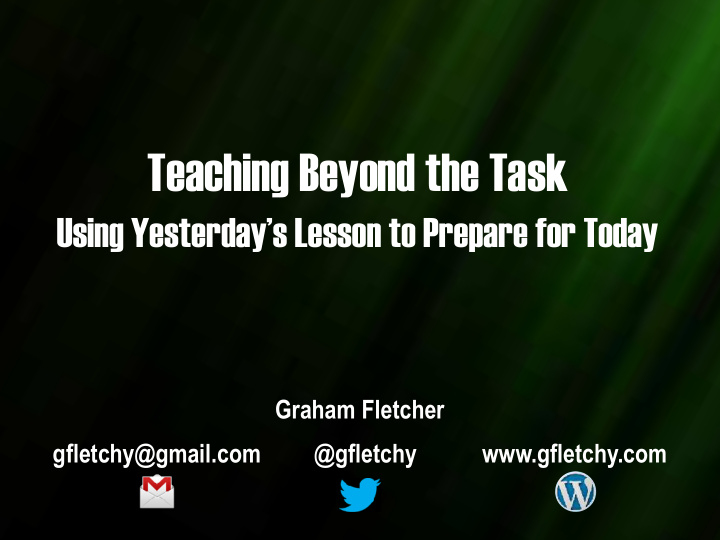



Teaching Beyond the Task Using Yesterday’s Lesson to Prepare for Today Graham Fletcher gfletchy@gmail.com @gfletchy www.gfletchy.com
? 3 Questions
? 1 Billion Circles
? 100 circles : minute 144,000 circles : day 1,000,000,000 would take 6944 days 19+ years with no sleep
? 2nd Question
Where does 1 billion go on the number line? 0 1 trillion
Where does 1 billion go on the number line? 0 1 trillion
? 3rd Question
Procedural Conceptual Fluency Understanding Application http://www.corestandards.org/other-resources/key-shifts-in-mathematics/
2000 o ff ered to buy for $50M 1.1 Billion Loss 24 Million Value 13 Billion Value
adapt : to become better suited to survive in ones environment.
adapt static
adapt static ME YOU
adapt YOU ME
MathMaker.com The place where lonely math teachers go to find task.
?
4 full bags & 3 Whoppers from the 5th bag 19 19 19 19 3
3-Act Tasks Act 1: • Real world problem or scenario presented • What do you notice? What do you wonder? • Make estimates Act 2: • Identify missing variables and missing variables to solve • Define solution path using variables Act 3: • Solve and interpret results of the solution • Validate answer
Most asked questions: • How often should we use 3-Act Tasks? • When should we use 3-Act tasks? How do they fit into the scope of a unit? • How long does one task usually take? • What if we don’t have the time?
5 The practices are: 1. Anticipating student responses to challenging mathematical tasks; 2. Monitoring students’ work on and engagement with the tasks; 3. Selecting particular students to present their mathematical work; 4. Sequencing the student responses that will be displayed in a specific order and; 5. C onnecting different students’ responses and connecting the responses to key mathematical ideas. MTMS: Vol. 14, No. 9, May 2009-5 Prac8ces for Orchestra8ng Produc8ve Mathema8cs Discussions
4 full bags 3 Whoppers from the 5th bag 19 Whoppers : bag
1 3 4 2 18 19 8 5 6 7 12 9 10 11 13 14 16 17 15
1-draw all count all
2-count all 1-draw all count all 2-count all
2-count all 1-draw all 3-count on count all 2-count all
2-count all 4-making tens from ones 1-draw all 3-count on count all 2-count all
2-count all 5-Place value 4-making tens partitioning from ones 1-draw all 3-count on count all 5-Place value partitioning 2-count all
6-Compensation 2-count all 5-Place value 4-making tens partitioning from ones 1-draw all 3-count on count all 5-Place value partitioning 2-count all
What do we know?
What do we know?
Hundreds and 0-99 Charts
Opening Work Session Closing
Opening Work Session Closing
Procedural Conceptual Fluency Understanding Application http://www.corestandards.org/other-resources/key-shifts-in-mathematics/
Using the digits 1-9 at most one time each, create 4 numbers that have a sum of 87. + + +
Estimation Station
16 100 20 20 1002 50 14 19 200 20 32
30 21 20 20 20 20 20 20
Hundreds and 0-99 Charts
Sounds of Imaging Numbers
Teaching Beyond the Task Using Yesterday’s Lesson to Prepare for Today Graham Fletcher gfletchy@gmail.com @gfletchy www.gfletchy.com
Recommend
More recommend